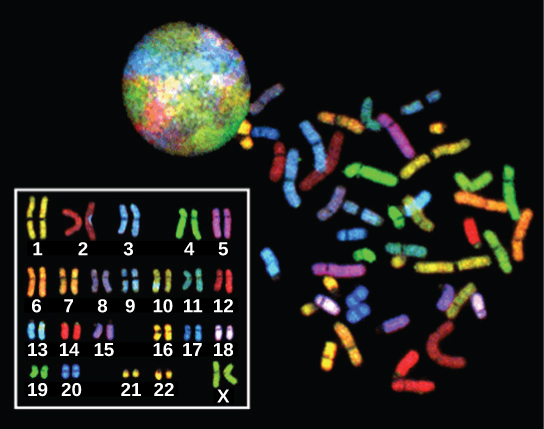How Many Copies Of Each Chromosome Are Found In Most Animal Cells Answers.com
Chapter 6: Introduction to Reproduction at the Cellular Level
6.1 The Genome
Learning Objectives
By the end of this section, yous will be able to:
- Describe the prokaryotic and eukaryotic genome
- Distinguish between chromosomes, genes, and traits
The continuity of life from ane cell to some other has its foundation in the reproduction of cells by mode of the prison cell bicycle. The cell cycle is an orderly sequence of events in the life of a cell from the division of a single parent cell to produce two new girl cells, to the subsequent sectionalisation of those daughter cells. The mechanisms involved in the cell bicycle are highly conserved across eukaryotes. Organisms as various as protists, plants, and animals use similar steps.
Genomic DNA
Before discussing the steps a cell undertakes to replicate, a deeper understanding of the construction and function of a cell'south genetic information is necessary. A cell's complete complement of DNA is chosen its genome. In prokaryotes, the genome is equanimous of a single, double-stranded Dna molecule in the form of a loop or circumvolve. The region in the cell containing this genetic material is called a nucleoid. Some prokaryotes also have smaller loops of DNA called plasmids that are not essential for normal growth.
In eukaryotes, the genome comprises several double-stranded, linear Deoxyribonucleic acid molecules (Figure 6.2) spring with proteins to course complexes chosen chromosomes. Each species of eukaryote has a characteristic number of chromosomes in the nuclei of its cells. Human body cells (somatic cells) have 46 chromosomes. A somatic cell contains 2 matched sets of chromosomes, a configuration known as diploid. The letter n is used to stand for a single fix of chromosomes; therefore a diploid organism is designated iin . Human cells that comprise 1 set of 23 chromosomes are called gametes, or sex activity cells; these eggs and sperm are designated northward, or haploid.

The matched pairs of chromosomes in a diploid organism are called homologous chromosomes. Homologous chromosomes are the aforementioned length and take specific nucleotide segments chosen genes in exactly the same location, or locus. Genes, the functional units of chromosomes, determine specific characteristics by coding for specific proteins. Traits are the different forms of a characteristic. For example, the shape of earlobes is a characteristic with traits of costless or attached.
Each re-create of the homologous pair of chromosomes originates from a different parent; therefore, the copies of each of the genes themselves may not be identical. The variation of individuals within a species is caused by the specific combination of the genes inherited from both parents. For example, there are three possible factor sequences on the man chromosome that codes for blood blazon: sequence A, sequence B, and sequence O. Considering all diploid homo cells take two copies of the chromosome that determines blood blazon, the blood type (the trait) is adamant by which 2 versions of the marker gene are inherited. Information technology is possible to take two copies of the same factor sequence, i on each homologous chromosome (for example, AA, BB, or OO), or two different sequences, such equally AB.
Minor variations in traits such as those for blood type, center color, and elevation contribute to the natural variation found inside a species. The sex chromosomes, X and Y, are the single exception to the dominion of homologous chromosomes; other than a small amount of homology that is necessary to reliably produce gametes, the genes found on the 10 and Y chromosomes are not the same.
Section Summary
Prokaryotes have a single loop chromosome, whereas eukaryotes have multiple, linear chromosomes surrounded past a nuclear membrane. Human somatic cells have 46 chromosomes consisting of ii sets of 22 homologous chromosomes and a pair of nonhomologous sex chromosomes. This is the 2n, or diploid, state. Human gametes accept 23 chromosomes or one complete set of chromosomes. This is the n, or haploid, state. Genes are segments of DNA that lawmaking for a specific poly peptide or RNA molecule. An organism's traits are determined in large part by the genes inherited from each parent, but also by the surround that they feel. Genes are expressed equally characteristics of the organism and each characteristic may take different variants called traits that are caused by differences in the DNA sequence for a gene.
Glossary
diploid: describes a cell, nucleus, or organism containing two sets of chromosomes (2n)
gamete: a haploid reproductive cell or sex jail cell (sperm or egg)
gene: the physical and functional unit of heredity; a sequence of Deoxyribonucleic acid that codes for a specific peptide or RNA molecule
genome: the entire genetic complement (Deoxyribonucleic acid) of an organism
haploid: describes a jail cell, nucleus, or organism containing one set of chromosomes (north)
homologous chromosomes: chromosomes of the same length with genes in the aforementioned location; diploid organisms take pairs of homologous chromosomes, and the members of each pair come from different parents
locus: the position of a gene on a chromosome
Source: https://opentextbc.ca/biology/chapter/6-1-the-genome/
Posted by: mcbridepootnott.blogspot.com

0 Response to "How Many Copies Of Each Chromosome Are Found In Most Animal Cells Answers.com"
Post a Comment